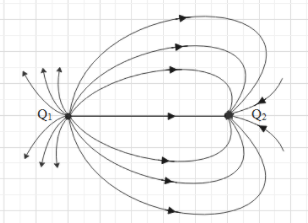
A few electric field lines for a system of two charges ${{Q}_{1}}$ and ${{Q}_{2}}$ fixed at two different points on the x-axis are shown in the figure. These lines suggest that

(This question has multiple correct options)
$\text{A}\text{. }\left| {{Q}_{1}} \right|>\left| {{Q}_{2}} \right|$
$\text{B}\text{. }\left| {{Q}_{1}} \right|<\left| {{Q}_{2}} \right|$
C. at a finite distance to the left of ${{Q}_{1}}$, the electric field is zero
D. at a finite distance to the right of ${{Q}_{2}}$, the electric field is zero

Answer
563.7k+ views
Hint: The charge with greater magnitude produces greater magnitude of electric field. This is depicted by drawing more number of field lines near the charge of greater magnitude. A positive point charge produces an electric field at a point that is directed radially outwards. A negative point charge produces an electric field at a point that is directed radially inwards.
Complete answer:
A positive point charge produces electric field lines that are directed radially outwards.
A negative point charge produces electric field lines that are directed radially inwards.
Therefore, in a system of one positive charge and negative charge, the electric field lines originate from the positive charge and they end at the negative charge.
In the given figure, we can see that the electric field lines are emerging from the charge ${{Q}_{1}}$ and they are ending at the charge ${{Q}_{2}}$.
Hence, the charge ${{Q}_{1}}$ is a positive charge and the charge ${{Q}_{2}}$ is negative charge.
The charge with greater magnitude produces a greater magnitude of electric field. This is depicted by drawing more number of field lines near the charge of greater magnitude.
Therefore, the magnitude of charge ${{Q}_{1}}$ is greater than the magnitude of charge ${{Q}_{2}}$.
i.e. $\left| {{Q}_{1}} \right|>\left| {{Q}_{2}} \right|$.
Therefore, option A is correct.
If we consider a point on the x-axis to the left of charge ${{Q}_{1}}$, then the electric field due to charge ${{Q}_{1}}$ is directed towards left and the electric field due to the charge ${{Q}_{2}}$ is directed towards right.

Therefore, there will be a point to the left of the charge where the two electric fields will cancel out each other and the net electric field is zero.
Similarly, there will be a point at finite distance to the right of charge ${{Q}_{2}}$ where the net electric field is zero.
Therefore, the options C and D are correct.
Hence, the correct options are A, C and D.
Note:
We can also note one more point that in the region that has greater magnitude of electric field, the field lines are closer than the region with smaller magnitude of electric field.
We can see that the field lines are closer near the charge ${{Q}_{1}}$ and the fields are more spaced near the charge ${{Q}_{2}}$. Hence, $\left| {{Q}_{1}} \right|>\left| {{Q}_{2}} \right|$.
Complete answer:
A positive point charge produces electric field lines that are directed radially outwards.
A negative point charge produces electric field lines that are directed radially inwards.
Therefore, in a system of one positive charge and negative charge, the electric field lines originate from the positive charge and they end at the negative charge.
In the given figure, we can see that the electric field lines are emerging from the charge ${{Q}_{1}}$ and they are ending at the charge ${{Q}_{2}}$.
Hence, the charge ${{Q}_{1}}$ is a positive charge and the charge ${{Q}_{2}}$ is negative charge.
The charge with greater magnitude produces a greater magnitude of electric field. This is depicted by drawing more number of field lines near the charge of greater magnitude.
Therefore, the magnitude of charge ${{Q}_{1}}$ is greater than the magnitude of charge ${{Q}_{2}}$.
i.e. $\left| {{Q}_{1}} \right|>\left| {{Q}_{2}} \right|$.
Therefore, option A is correct.
If we consider a point on the x-axis to the left of charge ${{Q}_{1}}$, then the electric field due to charge ${{Q}_{1}}$ is directed towards left and the electric field due to the charge ${{Q}_{2}}$ is directed towards right.

Therefore, there will be a point to the left of the charge where the two electric fields will cancel out each other and the net electric field is zero.
Similarly, there will be a point at finite distance to the right of charge ${{Q}_{2}}$ where the net electric field is zero.
Therefore, the options C and D are correct.
Hence, the correct options are A, C and D.
Note:
We can also note one more point that in the region that has greater magnitude of electric field, the field lines are closer than the region with smaller magnitude of electric field.
We can see that the field lines are closer near the charge ${{Q}_{1}}$ and the fields are more spaced near the charge ${{Q}_{2}}$. Hence, $\left| {{Q}_{1}} \right|>\left| {{Q}_{2}} \right|$.
Recently Updated Pages
Master Class 12 Business Studies: Engaging Questions & Answers for Success

Master Class 12 Economics: Engaging Questions & Answers for Success

Master Class 12 English: Engaging Questions & Answers for Success

Master Class 12 Maths: Engaging Questions & Answers for Success

Master Class 12 Social Science: Engaging Questions & Answers for Success

Master Class 12 Chemistry: Engaging Questions & Answers for Success

Trending doubts
What is meant by exothermic and endothermic reactions class 11 chemistry CBSE

Which animal has three hearts class 11 biology CBSE

10 examples of friction in our daily life

One Metric ton is equal to kg A 10000 B 1000 C 100 class 11 physics CBSE

1 Quintal is equal to a 110 kg b 10 kg c 100kg d 1000 class 11 physics CBSE

Difference Between Prokaryotic Cells and Eukaryotic Cells




